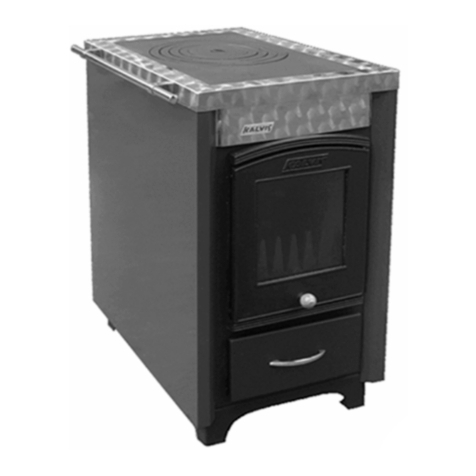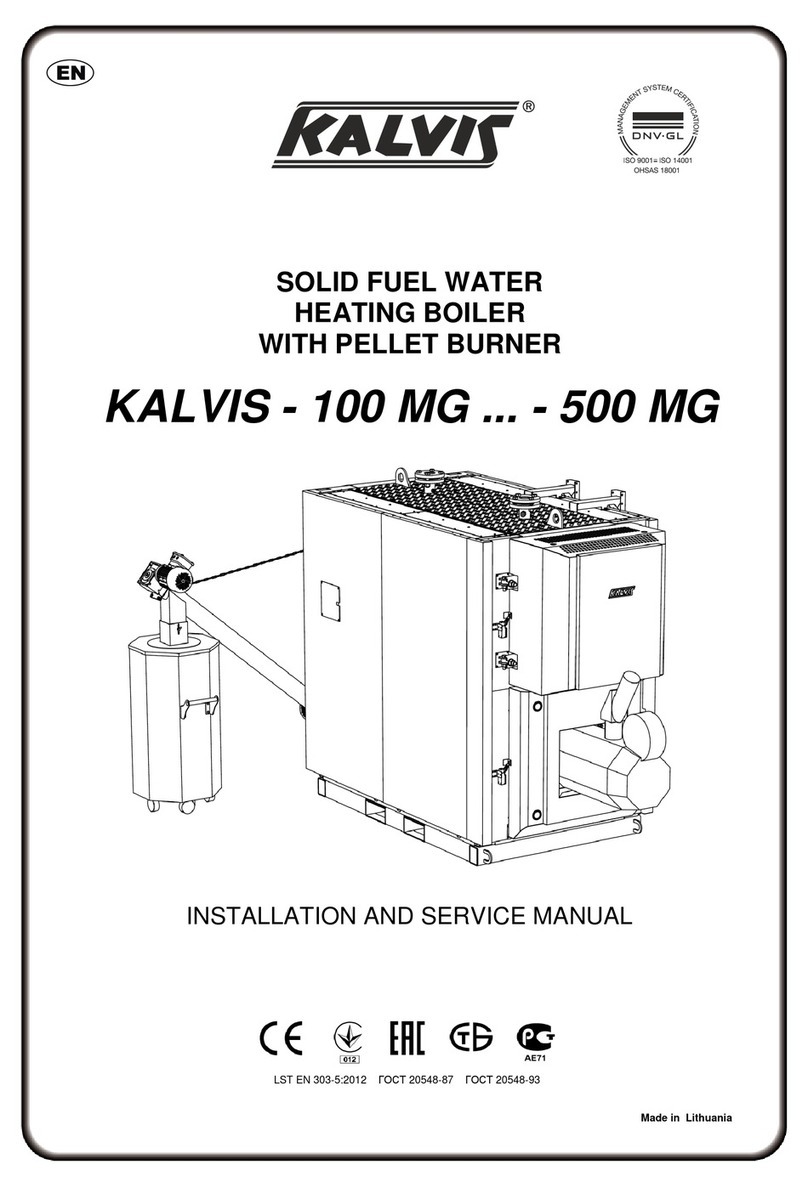- 8 -
4.3. Connection to heating system
Recommended connection method is shown in the 4a-4d fig
•Boiler may be connected to the heating system according to the project
prepared by heating equipment specialists or works may be performed
by a well qualified plumbing welder who is well acquainted with this
manual and boiler design
•Boiler should be connected by hot and return water pipes not smaller
than 1.5” in diameter
•Boiler may be connected to the heating system with the expansion tank,
where operating pressure does not exceed 0,15 MPa (1,5 kgf/cm2);
•If system pipes have valves, that disconnect boiler from the system,
mounted, they have to be fully opened. To avoid break down due to
inadvertence, valve handles should be removed.
•It is necessary to mount the protection valve that keeps the operating
pressure in the system not greater than 0,15 MPa (1,5 kgf/cm2).
•In order to avoid forming of condesate, which can significantly shorten
the lifespan of boiler, it is necessary to install a four way mixing valve,
or thermostatic valve in the system (see recommended connections),
which will maintain return water temperature above 55°C;
•It is recommended that boiler is inspected at leats once a year by a
competent plumbing engineer;
•Water draing pipe is used to let the water out of the system whem there
is a risk of freezing.
When boiler operates at smaller than nominal output, it‘s efficiency and
environmental performance drops. It is recommended to use connections
with accumulation tanks (see. 4c, 4d fig.). Minimum volume of
accumulation tank is quoted accotrding to the formula provided in 4d fig.
Mounting of burner and fuel tank with fuel pipe is described in
PellX 20kW user‘s manual.
5. Operation
Adults that are well acquainted with the design and users manual may
operate and service the boiler.
Attention! When firing humid fuel or saw dus, condensate and
combustion products may form agressive acids that may shorten the
lifespan of the boiler significantly.
It is prohibited to fire boiler with fine waste wood, due to explosion risk.
- 13 -
KALVIS – 6MPP 2009.05.18
5.1. System preparation for heating
Fill system with softened or desalinated water and let the air out. Check
if valves disconnecting boiler from the heating system are fully opened and
remove their handles.
5.2. Firing pellets
Boiler firing with pellets is described in Pellet burner PellX 20kW user‘s
manual.
5.3. Firing boiler with solid fuel (1 fig.)
Open damper (p.20), load some wood through door (p.5) on the fire
grate and ignite it. If coal will be fired, take 5 - 10 kg of wood and add a
layer (about 10 cm) of coal. Secondary air valve (p.19) has to be closed.
When fuel is well ignited, loading chamber may be filled with fuel
(wood, coal). Finer wood increases boiler output. Chminey draught is
adjusted with damper (p.20).
Wood should be loaded freely, so that it is able to slide down during
combustion.
Coal is added in layers, depending on desired heat output and quality.
Catalsyt plate should be removed when firing coal.
Adding fuel:
-Open door (p.4) and check is ash is not blocking fire grate air gaps.
Shake the bottom fuel layer, close door in 15...20 seconds;
-Remove draught adjusters (p.1) chain from the door damper (p.6), so
that the damper is closed tight;
-Carefully open fuel cover (p.18), in 5...10 seconds open cover fully
and add fuel;
-Close fuel cover;
-Attach adjuster‘s chain to the damper.
Secondary air valve (p.19) is opened when temperature in the boiler
rises to 60°C. Valve‘s position is adjusted depending on the fuel type and
combustion intensity.
Check the smoek color out of chimney. Smoke should be thin of a light
grey color. If smoke is thick and black it means incomplete combustion, not
enough secondary air. Open secondary air valve.
As a part of combustion process ash is formed, it blocks the openings in
fire grate, boiler capacity and combuistion intensity drops. Move the fuel
and ash by pressing the pedal of the fire grate mover. Excess of ash in an
ashtray blocks primary air supply, that is why ash needs removal.
Unless there is a necessity it is not recommended to open fuel loading
doors during combustion.
































